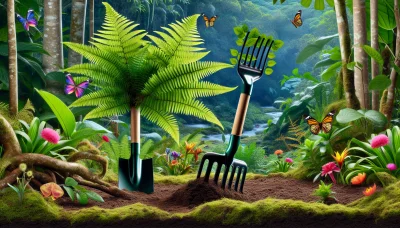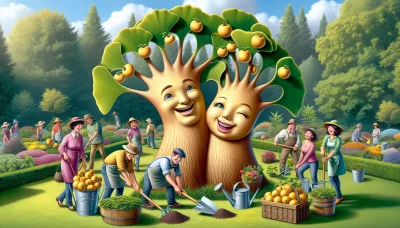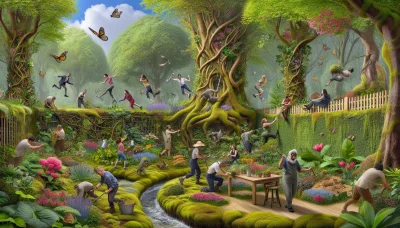Forest garden design Quiz
Test Your Knowledge
Question of
Introduction to Forest Garden Design
Forest garden design is a sustainable and innovative approach to gardening that mimics a natural woodland ecosystem. This method integrates trees, shrubs, perennials, and annuals into a multi-layered, productive garden space. It aims to create a self-maintaining system where ecological relationships between plants support their growth and resilience. Forest gardens are not only aesthetically pleasing but also provide a rich habitat for wildlife, help in carbon sequestration, and produce a variety of foods and materials. Embracing this concept in modern gardening can lead to more sustainable living spaces, promoting biodiversity and ecological balance.
Benefits of Forest Gardening
Forest gardening, a sustainable land management system, offers a multitude of benefits across ecological, economic, and social spheres. Ecologically, it enhances biodiversity, supporting a wide range of plant and animal species within a single ecosystem. This diversity not only helps in maintaining ecological balance but also in pest control, thereby reducing the need for chemical interventions. Economically, forest gardens can contribute to food security by providing a variety of crops throughout the year, reducing dependency on market-bought food, and potentially offering a source of income through the sale of surplus produce. Socially, forest gardening can strengthen community ties by encouraging collaborative efforts in garden management and produce sharing. It also promotes a deeper connection with nature, improving mental health and well-being by offering peaceful, green spaces for relaxation and recreation.
Key Elements of Forest Garden Design
- Canopy layers
- Shrubs
- Herbaceous plants
- Root crops
- Ground cover
- Climbers
Steps to Design Your Forest Garden
Designing a forest garden involves a series of thoughtful steps, from understanding your land to planting and beyond. Follow these steps to create a thriving ecosystem right in your backyard.
- Observe and Map Your Site: Spend time observing your site throughout the year. Note sunlight patterns, wind directions, and existing vegetation. Create a detailed map including these elements.
- Analyze Soil Conditions: Conduct soil tests to understand pH, texture, and nutrient levels. This will guide your plant selection and soil amendment strategies.
- Plan Water Management: Design your garden to capture and utilize rainwater efficiently. Consider incorporating swales, rain gardens, or ponds to manage water flow and availability.
- Choose Your Plants: Select a mix of trees, shrubs, perennials, and groundcovers that will thrive in your conditions. Aim for biodiversity to support a resilient ecosystem.
- Design Plant Layout: Arrange plants according to their mature size, sun requirements, and water needs. Consider the layers of a natural forest – canopy, understory, shrub layer, herbaceous layer, ground cover, and root zone.
- Prepare the Site: Based on your design, start clearing invasive species, amending soil, and shaping the land for water management features. Avoid compacting the soil as much as possible.
- Plant Your Garden: Begin with the larger elements like trees and shrubs, and then fill in with perennials and groundcovers. Mulch heavily to retain moisture and suppress weeds.
- Establish and Maintain: Keep the garden well-watered during its first few years until plants are established. Gradually reduce maintenance as your forest garden begins to self-regulate. Regularly observe and adapt your practices to support the evolving ecosystem.
Common Plants Used in Forest Gardens
| Name | Preferred Conditions | Benefits |
|---|---|---|
| Apple Tree (Malus domestica) | Full sun, well-drained soil | Provides fruits, attracts pollinators |
| Blueberry (Vaccinium spp.) | Acidic, well-drained soil | Produces berries, supports wildlife |
| Raspberry (Rubus idaeus) | Full sun to partial shade, moist soil | Produces berries, provides habitat |
| Hazelnut (Corylus avellana) | Well-drained soil, full sun to partial shade | Produces nuts, supports biodiversity |
| Elderberry (Sambucus nigra) | Moist, well-drained soil, full sun to partial shade | Produces flowers and berries, medicinal properties |
| Comfrey (Symphytum officinale) | Moist, well-drained soil, full sun to partial shade | Soil conditioner, attracts pollinators, medicinal |
Maintaining Your Forest Garden
To ensure the health and productivity of a forest garden over time, it's essential to adopt a series of maintenance practices. These include regular monitoring and management of plant species to ensure biodiversity, mulching to retain soil moisture and suppress weeds, and the addition of compost to enrich the soil. Pruning is also critical to remove any dead or diseased wood and to promote air circulation. Implementing companion planting can further enhance plant health by attracting beneficial insects and repelling pests. Regular observation is key to identifying and addressing issues early, ensuring your forest garden thrives for years to come.












